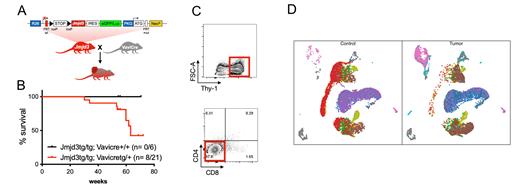Introduction:
T-cell acute lymphoblastic leukemia (T-ALL) is an aggressive hematological malignancy that accounts for 15% of pediatric and 25% of adult ALL cases. Despite an improved survival rate due to intensified chemotherapy and bone marrow transplantation, still 20% of T-ALL patients are primary refractory to the standard treatment or relapse, and have a poor clinical outcome. T-ALL patients can be classified into molecular genetic subgroups based on the expression or genomic alterations of specific oncogenic transcription factors. One such subgroup the early T-cell precursor ALL (ETP-ALL) is a heterogeneous subgroup of immature leukemias that often display high expression of LYL1 and LMO2. It's important to improve our knowledge of T-ALL biology and developing novel targeted anti-TALL therapies. We previously showed that the H3K27 demethylase Jmjd3 plays an important role in T-ALL and is a good candidate for the treatment of T-cell leukemia.
Aim: Identify the role of Jmjd3 in the initiation of immature T-ALL.
Methods: We generated a conditional Rosa26- Jmjd3 overexpression mouse model (Figure 1A), and crossed it with a hematopoietic-specific Vav-icre mice, to obtain Jmjd3 Vav mice. To investigate the role of Jmjd3 in tumor initiation, we monitored survival of a Jmjd3 Vav cohort. Arising tumors were characterized by immunohistochemistry, flow cytometry, and were transplanted into secondary immunodeficient recipients. To characterize the pre-leukemic compartment, we performed single cell feature barcoding and RNA sequencing. Also bulk RNAseq and proteomics were performed on primary and transplanted Jmjd3-driven tumors. To investigate the role of Jmjd3 in immature T-cell biology in human and mice, we analyzed thymi from 8-weeks-old control and Jmjd3 Vavmice, and performed OP9-DL4 stromal co-cultures with transduced CD34+ human cord blood cells that overexpressed JMJD3, respectively. We used ETP-ALL patient-derived xenografts (PDX) models to validate markers identified in single cell analysis.
Results:
We found that hematopoietic Jmjd3 overexpression resulted in hematological malignancies with 38% penetrance (n= 8/21) and a median survival of 63 weeks (Figure 1B). Immunohistochemistry confirmed overexpression of Jmjd3, decreased levels of H3K27me3, and increased levels of H3K27ac in Jmjd3 Vav tumors. Immunophenotypic analysis revealed immature Thy1.1 +CD4 -CD8 - cells in all obtained Jmjd3 Vav tumors (Figure 1C), indicative of an immature the early T-cell precursor (ETP)-like ALL. These immature T-ALLs gave rise to primary (7 weeks) and secondary (3 weeks) transplants upon their transplantation in immunocompromised mice. Bulk RNAseq confirmed that the transcriptional feature of the primary tumor were maintained upon transplantation. The role of Jmjd3 in stimulating immature thymocyte development was confirmed in thymi from 8-weeks-old Jmjd3 Vavmice and could be validated as well in human T-cell development using stromal OP9-DL4 co-cultures. Finally, we used single cell sequencing technologies to characterize both transcriptional features and cell-surface markers within the tumor fraction (Figure 1D). We confirmed that the tumor cluster was ETP-like with absence of CD1, CD5 and mature T-cell markers, and expression of CD44, Lyl1, and myeloid markers. Furthermore, we could identify cell-surface in immature Jmjd3-driven tumors that were also present in human T-cell stromal culture and ETP-ALL PDXs.
Conclusion: We identified Jmjd3 as a driver of immature thymocyte populations that give rise to ETP-ALL.
Disclosures
No relevant conflicts of interest to declare.


This feature is available to Subscribers Only
Sign In or Create an Account Close Modal